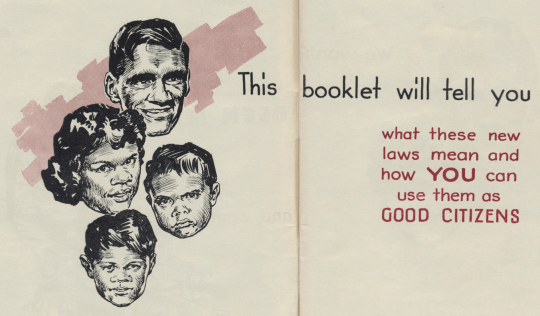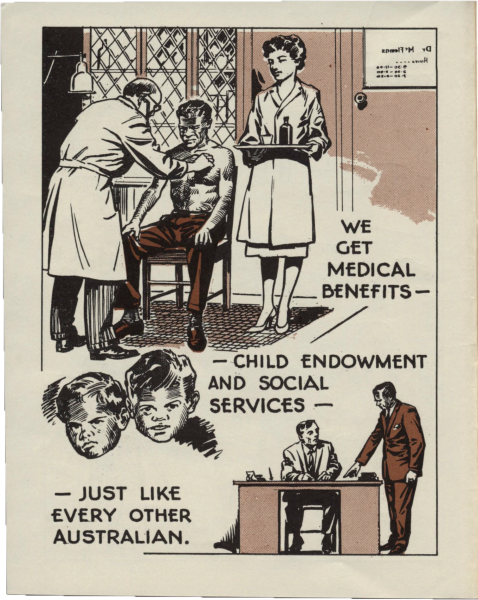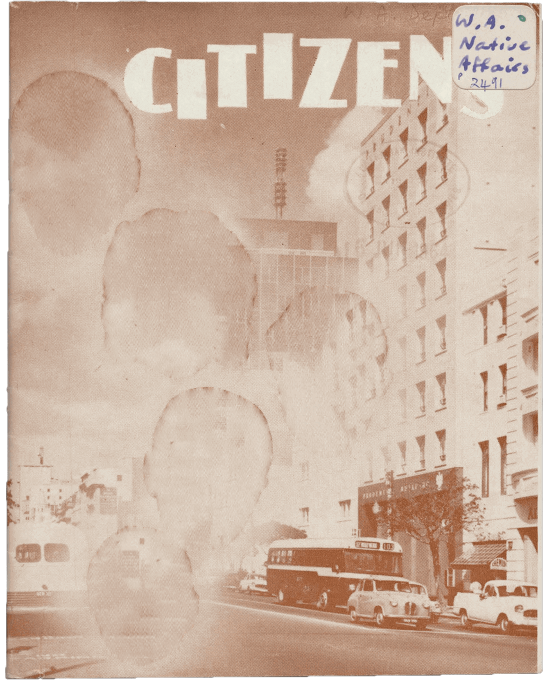
Booklet instructs people to assimilate to get government payments
Even though social security was a federal responsibility, the Western Australian Department of Native Welfare issued a booklet for Aboriginal people instructing them to access payments through state-based officers.
We get medical benefits – child endowment and social services – just like every other Australian. BUT – we don’t expect the government to do everything for us.
| Attachment | Size |
|---|---|
| citizens-booklet-excerpts.pdf | 24.42 MB |
| Attachment | Size |
|---|---|
| citizens-booklet-plaintext.docx | 83.69 KB |
The Social Services Act 1959 meant most Aboriginal people were entitled to federal social security benefits by 1960. In 1962, Aboriginal people were also granted the right to enrol and vote at federal elections.
However, to access their entitlements, Aboriginal people were still expected to assimilate to white Australian culture. Those who the government considered ‘nomadic’ were not entitled to benefits.
In 1964, following changes to the Western Australian Native Welfare Act 1963, the state Department of Native Welfare issued a booklet called Citizens. It told Aboriginal people about the government’s expectations of how they should conform and behave in order to assimilate.
Assimilation messaging
The Western Australian Minister of Native Welfare, EH Lewis, told readers ‘This booklet has been issued to help you to meet the new problems you will encounter’.
The booklet used pictures and large text. It covered 3 main topics in simple language: good citizenship, voting rights and liquor.
To be a good citizen, Aboriginal people were expected to:
- obey the law
- have a job
- send their children to school
- take care of their health
- maintain their homes.
The overall message was that Aboriginal people needed to assimilate in order to access citizenship rights including social services.

Examples of ideal assimilation
To show what an ideal assimilated citizen looked like, the booklet used examples of an assimilated Aboriginal family. Significantly, the examples used a family of parents and children, which doesn’t represent Aboriginal ideas of extended family networks and kinship.
In one example an Aboriginal man is talking with an official. The Aboriginal man is pictured saying ‘We get medical benefits – child endowment and social services – just like every other Australian’. On the following page he is pictured saying ‘BUT – we don’t expect the government to do everything for us’.
The turning of the page in between the pictures in this example emphasises the common assumption at the time that if Aboriginal people got payments they might see it as their income and not as a safety net. The writers seem to be pointing out that this isn’t the expectation of an assimilated citizen.

Advice about getting payments
The booklet also told readers how to apply for government payments. It said that ‘Your Welfare Officer will help you with advice and applications’.
This advice from the Western Australian state government was opposite to advice given by the Federal Council of Aborigines Advancement (FCAA, later FCAATSI) in their Yinjilli leaflet. The FCAA’s concern was that state Welfare Officers prevented people getting payments.
Civil rights and assimilation
Citizens shows how strongly the government expected Aboriginal people to assimilate in the early 1960s and how ideas of citizenship linked to social services.
The Social Services Act's discriminatory passages that excluded Aboriginal people from government payments were removed in 1966. Strong ideas and expectations about assimilation continued until later in the decade, but were beginning to be widely discredited.
Citizens was published by the Western Australian Department of Native Welfare and collected by AIATSIS, who holds the original.
We have reproduced the cover of Citizens here but removed the photographs of Aboriginal people’s faces. There was no record found of who these people were and therefore it was not possible to gain appropriate permissions.
Read the full version of Citizens on the website Right wrongs, which is about the 1967 Referendum and is produced by the ABC, National and State Libraries Australasia and AIATSIS.
Citation
Lewis EH (1964) Citizens, Department of Native Welfare, Western Australian Government.
